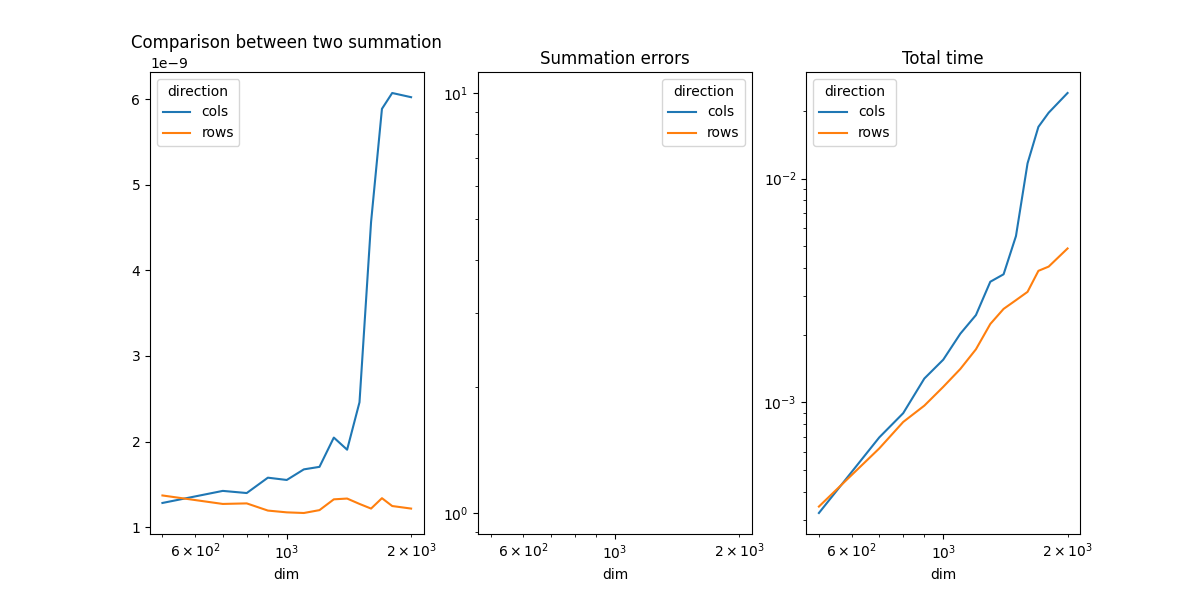Note
Click here to download the full example code
Measuring CPU performance with a vector sum#
The example compares the time spend in computing the sum of all coefficients of a matrix when the function walks through the coefficients by rows or by columns.
Vector Sum#
from tqdm import tqdm
import numpy
import matplotlib.pyplot as plt
from pandas import DataFrame
from onnx_extended.ext_test_case import measure_time, unit_test_going
from onnx_extended.validation.cpu._validation import vector_sum_array as vector_sum
obs = []
dims = [500, 700, 800, 900, 1000, 1100, 1200, 1300, 1400, 1500, 1600, 1700, 1800, 2000]
if unit_test_going():
dims = dims[:3]
for dim in tqdm(dims):
values = numpy.ones((dim, dim), dtype=numpy.float32).ravel()
diff = abs(vector_sum(dim, values, True) - dim**2)
res = measure_time(lambda: vector_sum(dim, values, True), max_time=0.5)
obs.append(
dict(
dim=dim,
size=values.size,
time=res["average"],
direction="rows",
time_per_element=res["average"] / dim**2,
diff=diff,
)
)
diff = abs(vector_sum(dim, values, False) - dim**2)
res = measure_time(lambda: vector_sum(dim, values, False), max_time=0.5)
obs.append(
dict(
dim=dim,
size=values.size,
time=res["average"],
direction="cols",
time_per_element=res["average"] / dim**2,
diff=diff,
)
)
df = DataFrame(obs)
piv = df.pivot(index="dim", columns="direction", values="time_per_element")
print(piv)
0%| | 0/14 [00:00<?, ?it/s]
7%|7 | 1/14 [00:01<00:16, 1.26s/it]
14%|#4 | 2/14 [00:02<00:14, 1.18s/it]
21%|##1 | 3/14 [00:03<00:13, 1.22s/it]
29%|##8 | 4/14 [00:04<00:12, 1.20s/it]
36%|###5 | 5/14 [00:05<00:10, 1.17s/it]
43%|####2 | 6/14 [00:07<00:09, 1.18s/it]
50%|##### | 7/14 [00:08<00:08, 1.16s/it]
57%|#####7 | 8/14 [00:09<00:07, 1.25s/it]
64%|######4 | 9/14 [00:10<00:05, 1.19s/it]
71%|#######1 | 10/14 [00:11<00:04, 1.16s/it]
79%|#######8 | 11/14 [00:12<00:03, 1.15s/it]
86%|########5 | 12/14 [00:14<00:02, 1.15s/it]
93%|#########2| 13/14 [00:15<00:01, 1.18s/it]
100%|##########| 14/14 [00:16<00:00, 1.18s/it]
100%|##########| 14/14 [00:16<00:00, 1.18s/it]
direction cols rows
dim
500 1.283317e-09 1.371010e-09
700 1.424335e-09 1.271919e-09
800 1.399220e-09 1.278334e-09
900 1.578634e-09 1.194463e-09
1000 1.551920e-09 1.173616e-09
1100 1.675758e-09 1.166105e-09
1200 1.705026e-09 1.199596e-09
1300 2.047067e-09 1.325730e-09
1400 1.905451e-09 1.334907e-09
1500 2.459402e-09 1.272129e-09
1600 4.564758e-09 1.217785e-09
1700 5.886505e-09 1.339135e-09
1800 6.071599e-09 1.247563e-09
2000 6.022610e-09 1.217832e-09
Plots#
piv_diff = df.pivot(index="dim", columns="direction", values="diff")
piv_time = df.pivot(index="dim", columns="direction", values="time")
fig, ax = plt.subplots(1, 3, figsize=(12, 6))
piv.plot(ax=ax[0], logx=True, title="Comparison between two summation")
piv_diff.plot(ax=ax[1], logx=True, logy=True, title="Summation errors")
piv_time.plot(ax=ax[2], logx=True, logy=True, title="Total time")
fig.savefig("plot_bench_cpu_vector_sum.png")

/home/xadupre/.local/lib/python3.10/site-packages/pandas/plotting/_matplotlib/core.py:744: UserWarning: Data has no positive values, and therefore cannot be log-scaled.
labels = axis.get_majorticklabels() + axis.get_minorticklabels()
The summation by rows is much faster as expected. That explains why it is usually more efficient to transpose the first matrix before a matrix multiplication.
Total running time of the script: ( 0 minutes 18.305 seconds)